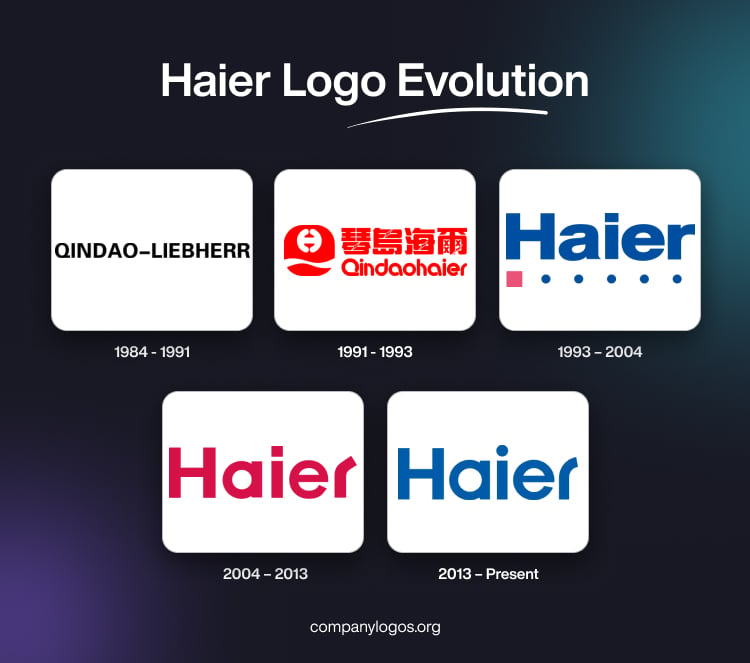
Haier is arguably the leading brand in home appliances and smart home solutions worldwide. Founded in 1984 in Qingdao, China, the brand began as a fledgling manufacturer of refrigerators. However, over the years, it made a massive turnaround through strict enforcement of quality control. Also, the company embraced strategic acquisitions as a policy to achieve international expansion. Its forward-looking vision has led it to embrace the Internet of Things and turn ordinary home appliances into smart home solutions.
The Haier logo has undergone a significant evolution alongside the brand’s transformation from a struggling Chinese appliance factory into a global leader in home appliances and smart home ecosystems. The Haier logo history shows the broader corporate journey of the company marked by strategic shifts, modernisation, and increasing international influence. The article explores the various changes undertaken by the Haier logo, among other details of the company.
The Genesis of the Haier Logo (1984 – 1991)
The original name of Haier was Qingdao Refrigerator Co., which became Qingdao-Liebherr in 1984 after a joint venture with the West German heavy equipment and appliance company, Liebherr. Thus, the original logo of the company was a combination of a graphical emblem and the wordmark “QINDAO-LIEBHERR” in bold, black, uppercase.
The circular emblem depicting the letter “Q” had a thick black outline and a slanted accent near the bottom. It contained thick intertwined letters “H” and “L” against a white background. The thicker letter “L” was placed at the centre of the stretched letter “H”, but appeared slightly below.


(1991 – 1993)
In 1991, the company changed its name to Qindaohaier. Here, “Haier” is derived by shortening the German name “Liebherr” to just the last two letters. The logo in red showed a graphical emblem and the wordmark in both Chinese and English. The graphical emblem was made of an abstract letter “Q”, where the upper part of “Q” looked like a bell.
Inside the bell shaped portion of the graphical emblem appeared a small white element comprising two small opening and closing parentheses joined in the middle. The lower portion of the letter “Q” in red was separated from the main part by a small white wavy strip.

(1993 – 2004)
The 1993 logo iteration saw the brand name “Haier” written in a bold and blue title case using a modern and distinct sans-serif typeface. Below the wordmark appeared a small crimson square accent followed by a sequence of smaller blue circles arranged in a line to convey a sense of digital connectivity. The overall logo conveyed a sleek image of a company known for its quality and innovation.

(2004 – 2013)
As Haier entered global markets and expanded abroad, it streamlined its visual identity. The 2004 logo version featured the brand name in red with a single-storey “a” and a more unified, bold, and energetic sans-serif typeface. Here, the letter “r” was curled at an angle to add a touch of uniqueness and dynamism.
This logo did not have any graphical element but a minimalist, clean, and straightforward presentation. Besides, the use of a single colour was striking and emphasised energy and confidence. It aligned with Haier’s vision of being a forward-looking brand in the appliance industry.

(2013 – Present)
The current logo was introduced in 2013, wherein the logotype was further refined by using a minimalist, clean, and modern sans-serif typeface in bold blue. Designed by Dongdao, the letter “r” was made smoother, and “i” was given a circular dot instead of the square one in the previous iterations. The deep blue colour of the logotype symbolises reliability and professionalism.

(2019) (35th Anniversary Logo)
The 35th anniversary logo was introduced in 2019, where the present logotype was accompanied by the numerals “35th” in a bigger size. The logotype in white was set against a light purple background and was followed below by the tagline “1984-2019”.

The Elements of the Haier Logo
Font
The wordmark used in the Haier logo is written using a clean, modern, and slightly rounded sans-serif typeface. It appears similar to ITC Avant Garde Demi Bold and presents a circular dot above the letter “i” to probably convey global presence or precision. Also, the letter “r” is made smoother and more streamlined with a distinctive cut.
Colour
The Haier logo is designed using a saturated blue shade against a white background to convey depth and stability in the evolution of the brand.
The History of Haier
Haier is a global leader in home appliances and consumer electronics and was founded in 1984 in Qingdao, China. The company’s origins can be traced back to a small refrigerator factory known as Qingdao Refrigerator Co., which was struggling with poor quality and limited production. However, when Zhang Ruimin took over as the director of the factory, he implemented strict quality control measures. For instance, he famously used to smash defective refrigerators with a sledgehammer to demonstrate his commitment to excellence. This defining moment became a cornerstone of Haier’s philosophy of quality-first manufacturing.
During the late 1980s and 1990s, Haier expanded beyond refrigerators into a full range of household appliances, which included washing machines, air conditioners, and televisions. The company adopted a strategy of “diversification, internationalisation, and brand building”, which allowed it to grow rapidly across domestic and global markets.
In the 2000s, Haier became a symbol of China’s manufacturing modernisation. It also established a strong international presence by setting up production bases in the United States, Europe, the Middle East, and Africa, and by acquiring well-known brands and facilities abroad. One of its major milestones came in 2016, when Haier acquired GE Appliances in the U.S. This significantly enhanced its presence in North America and marked a significant step towards becoming a global appliance powerhouse.
Haier also embraced innovation and digital transformation in the 2010s and 2020s, wherein it developed smart home ecosystems under its Haier Smart Home brand. The company integrated IoT (Internet of Things) technology to connect appliances and improve user experience. In fact, it positioned itself as a leader in the smart living space.
As a company, Haier operates under the Haier Group, which includes several major sub-brands such as Casarte, Leader, AQUA, and GE Appliances. It serves millions of consumers in over 160 countries. So, what began as a struggling factory producing refrigerators went on to become a Fortune Global 500 enterprise. Haier’s journey reflects China’s broader transformation into a centre of global innovation and manufacturing excellence.
Interesting Facts About Haier
- Haier’s founder, Zhang Ruimin, implemented a zero-defect policy early on. He had famously smashed 76 defective refrigerators in front of his employees in 1985 to highlight the importance of quality control. This landmark event is still regarded as a symbol of Haier’s commitment to excellence and sparked a nationwide focus on product quality.
- The company started as a debt-ridden, poorly managed refrigerator factory in Qingdao. After near bankruptcy in the 1980s, it turned around spectacularly and became China’s leading home appliance brand within a decade. Today, Haier is recognised as the world’s number one home appliance brand for over 12 consecutive years.
- The name “Haier” comes from the last two syllables of the Chinese transliteration of “Liebherr”, the German company with whom the original factory partnered for technology and management transfer in 1984.
- Haier has acquired numerous international companies over the years. These included Fisher & Paykel from New Zealand (2012), GE Appliances in the United States (2016), Sanyo’s Southeast Asian operations, and Italy’s Candy group (2018).
- In the United States, there is a “Haier Road” named in the company’s honour. It is the first road in the country to carry the name of a Chinese brand. This was a tribute from the local government to Haier’s contribution to economic development and employment in the area.
- Haier is considered a global pioneer in the Internet of Things (IoT) for home appliances. It rebranded itself as Haier Smart Home Co., Ltd in 2019 and led the industry in smart ecosystem innovation and digital transformation.
- Haier’s management philosophy and turnaround story have been studied at Harvard Business School and business schools worldwide. Its unique management practices, such as employee autonomy and user-centric product development, are considered world-class cases in corporate transformation.
- By the late 1990s, Haier had expanded aggressively into international markets. It established its first overseas industrial park in the United States in 1999, which was a highly ambitious and, at the time, unconventional strategy for a Chinese brand.
- Haier is the global leader in refrigerators, washing machines, and wine coolers. It has more than 120,000 employees worldwide and maintains a major influence in both developed and emerging markets.
Finally
The Haier logo iterations show the journey of the company from a fledgling regional manufacturer to a global leader offering smart home solutions. The logo evolution reflects a strategy of modernisation, international expansion, and an increasing emphasis on digital connectivity and consumer experience. It is a testament to Haier’s ability to adapt its visual identity to each phase of its corporate growth while maintaining continuity and brand equity throughout its history.